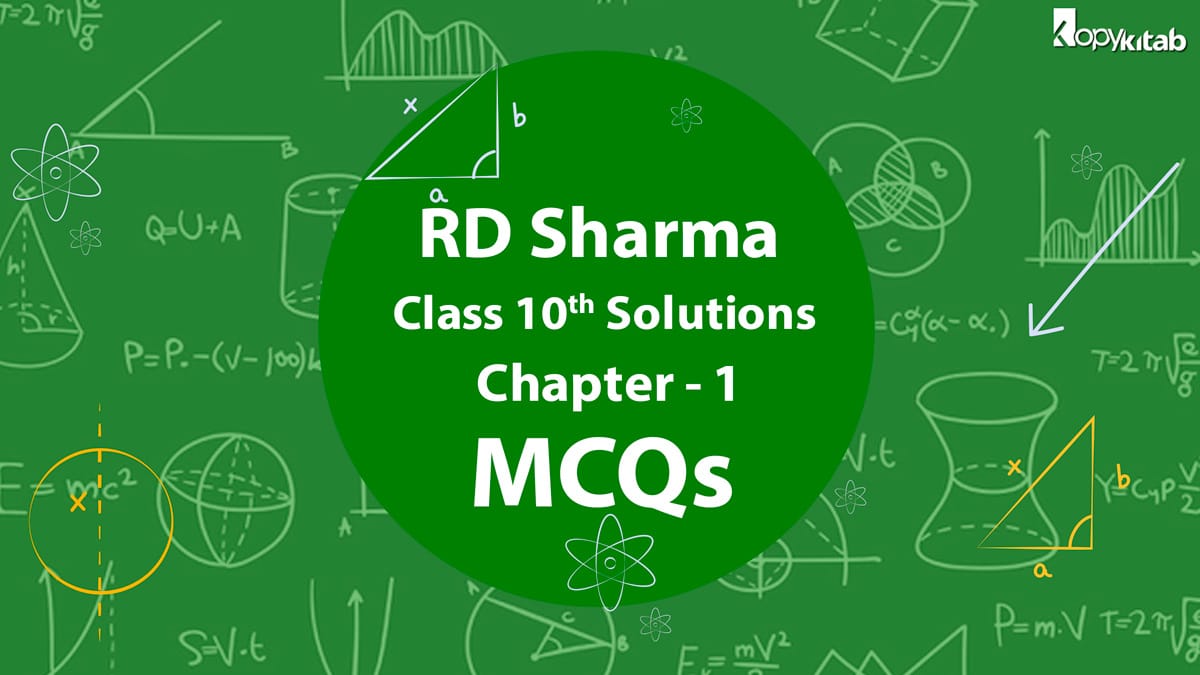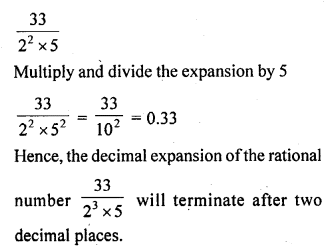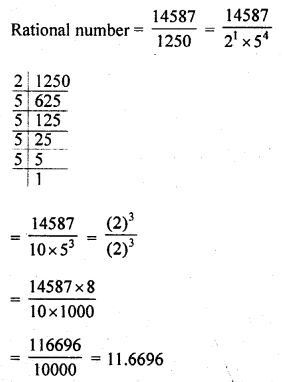
RD Sharma Class 10 Solutions Chapter 1 MCQs: If you’re facing any difficulty in understanding a question from this exercise, the RD Sharma Solutions Class 10 is the perfect resource for you. Students can download RD Sharma Class 10 Solutions Chapter 1 MCQs Free PDF from the below-mentioned link.
Access RD Sharma Class 10 Solutions Chapter 1 MCQs
Question 1.
The exponent of 2 in the prime factorization of 144, is
(a) 4
(b) 5
(c) 6
(d) 3
Solution:
(a)
Question 2.
The LCM of the two numbers is 1200. Which of the following cannot be their HCF?
(a) 600
(b) 500
(c) 400
(d) 200
Solution:
(b) LCM of two numbers = 1200
The HCF of these two numbers will be the factor of 1200
500 cannot be its HCF
Question 3.
If n = 23 x 34 x 44 x 7, then the number of consecutive zeroes in n, where n is a natural number, is
(a) 2
(b) 3
(c) 4
(d) 7
Solution:
(c) Because it has four factors n = 23 x 34 x 44 x 7
It has 4 zeroes
Question 4.
The sum of the exponents of the prime factors in the prime factorization of 196, is
(a) 1
(b) 2
(c) 4
(d) 6
Solution:
(c)
Question 5.
The number of decimal places after which the decimal expansion of the rational number 2322×5 will terminate is
(a) 1
(b) 2
(c) 3
(d) 4
Solution:
(b)
Question 6.
(a) an even number
(b) an odd number
(c) An odd prime number
(d) a prime number
Solution:
(a)
Question 7.
If two positive integers a and b are expressible in the form a = pq2 and b = p2q ; p, q being prime numbers, then LCM (a, b) is
(a) pq
(b) p3q3
(c) p3q2
(d) p2q2
Solution:
(c) a and b are two positive integers and a =pq2 and b = p3q, where p and q are prime numbers, then LCM=p3q2
Question 8.
In Q. No. 7, HCF (a, b) is
(a) pq
(b) p3q3
(c) p3q2
(d) p2q2
Solution:
(a) a = pq2 and b =p3q where a and b are positive integers and p, q are prime numbers, then HCF =pq
Question 9.
If two positive integers tn and n arc are expressible in the form m = pq3 and n = p3q2, where p, q are prime numbers, then HCF (m, n) =
(a) pq
(b) pq2
(c) p3q3
(d) p2q3
Solution:
(b) m and n are two positive integers and m = pq3 and n = pq2, where p and q are prime numbers, then HCF = pq2
Question 10.
If the LCM of a and 18 is 36 and the HCF of a and 18 is 2, then a =
(a) 2
(b) 3
(c) 4
(d) 1
Solution:
(c) LCM of a and 18 = 36
and HCF of a and 18 = 2
Product of LCM and HCF = product of numbers
36 x 2 = a x 18
a = 36×218 = 4
Question 11.
The HCF of 95 and 152, is
(a) 57
(b) 1
(c) 19
(d) 38
Solution:
(c) HCF of 95 and 152 = 19
Question 12.
If HCF (26, 169) = 13, then LCM (26, 169) =
(a) 26
(b) 52
(f) 338
(d) 13
Solution:
(c) HCF (26, 169) = 13
LCM (26, 169) = 26×16913 = 338
Question 13.
(a) 1
(b) 2
(c) 3
(d) 4
Solution:
(b)

Question 14.
The decimal expansion of the rational 145871250 number will terminate after
(a) one decimal place
(b) two decimal place
(c) three decimal place
(d) four decimal place
Solution:
(d)
Question 15.
If p and q are co-prime numbers, then p2 and q2 are
(a) co-prime
(b) not co-prime
(c) even
(d) odd
Solution:
(a) p and q are co-prime, then
p2 and q2 will also be coprime
Question 16.
Which of the following rational numbers has a terminating decimal?
(a) (i) and (ii)
(b) (ii) and (iii)
(c) (i) and (iii)
(d) (i) and (iv)
Solution:
(d) We know that a rational number has a terminating decimal if the prime factors of its denominator are in the form of 2m x 5n
16225 and 7250 have terminating decimals
Question 17.
If 3 is the least prime factor of number a and 7 is the least prime factor of number b, then the least prime factor of a + b is
(a) 2
(b) 3
(c) 5
(d) 10
Solution:
(a) 3 is the least prime factor of a
7 is the least prime factor of b, then
The Sum of a and b will be divisible by 2
2 is the least prime factor of a + b
Question 18.
3.27¯ is
(a) an integer
(b) a rational number
(c) a natural number
(d) an irrational number
Solution:
(b) 3.27¯ is a rational number
Question 19.
The smallest number by which √27 should be multiplied to get a rational number is
(a) √27
(b) 3√3
(c) √3
(d) 3
Solution:
(c)
Question 20.
The smallest rational number by which 13 should be multiplied so that its decimal expansion terminates after one place of decimal, is
(a) 310
(b) 110
(c) 3
(d) 3100
Solution:
(a) The smallest rational number which should be multiplied by 13 to get a terminating
Question 21.
If n is a natural number, then 92n – 42n is always divisible by
(a) 5
(b) 13
(c) Both 5 and 13
(d) None of these
Solution:
(c)
Question 22.
If n is any natural number, then 6n – 5n always ends with
(a) 1
(b) 3
(c) 5
(d) 7
Solution:
(a) n is any natural number and 6n – 5n
We know that 6n ends with 6 and 5n end with 5
6n – 5n will end with 6 – 5 = 1
Question 23.
If the LCM and HCF of two rational numbers are equal, then the numbers must be
(a) prime
(b) co-prime
(c) composite
(d) equal
Solution:
(d) LCM and HCF of two rational numbers are equal Then those must be equal
Question 24.
If the sum of the LCM and HCF of two numbers is 1260 and their LCM is 900 more than their HCF, then the product of the two numbers is
(a) 203400
(b) 194400
(c) 198400
(d) 205400
Solution:
(b) Sum of LCM and HCF of two numbers = 1260
LCM = 900 more than HCF
LCM = 900 +HCF
But LCM = HCF = 1260
900 + HCF + HCF = 1260
=> 2HCF = 1260 – 900 = 360
=> HCF = 180
and LCM = 1260 – 180 = 1080
Product = LCM x HCF = 1080 x 180 = 194400
Product of numbers = 194400
Question 25.
The remainder when the square of any prime number greater than 3 is divided by 6, is
(a) 1
(b) 3
(c) 2
(d) 4
Solution:
(a)
Question 26.
For some integer m, every even integer is of the form
(a) m
(b) m + 1
(c) 2m
(d) 2m + 1
Solution:
(c) We know that even integers are 2, 4, 6, …
So, it can be written in the form of 2m Where, m = Integer = Z
[Since the integer is represented by Z]
or m = …, -1, 0, 1, 2, 3, …
2m = …, -2, 0, 2, 4, 6, …
Alternate Method
Let ‘a’ be a positive integer.
On dividing ‘a’ by 2, let m be the quotient and r be the remainder.
Then, by Euclid’s division algorithm, we have
a – 2m + r, where a ≤ r < 2 i.e., r = 0 and r = 1
=> a = 2 m or a = 2m + 1
When, a = 2m for some integer m, then clearly a is even.
Question 27.
For some integer q, every odd integer is of the form
(a) q
(b) q + 1
(c) 2q
(d) 2q + 1
Solution:
(d) We know those odd integers are 1, 3, 5,…
So, it can be written in the form of 2q + 1 Where q = integer = Z
or q = …, -1, 0, 1, 2, 3, …
2q + 1 = …, -3, -1, 1, 3, 5, …
Alternate Method
Let ‘a’ be given a positive integer.
On dividing ‘a’ by 2, let q be the quotient and r be the remainder.
Then, by Euclid’s division algorithm, we have
a = 2q + r, where 0 ≤ r < 2
=> a = 2q + r, where r = 0 or r = 1
=> a = 2q or 2q + 1
When a = 2q + 1 for some integer q, then clearly a is odd.
Question 28.
n2 – 1 is divisible by 8, if n is
(a) an integer
(b) a natural number
(c) an odd integer
(d) an even integer
Solution:
(c)

At k = -1, a = 4(-1)(-1 + 1) = 0 which is divisible by 8.
At k = 0, a = 4(0)(0 + 1) = 4 which is divisible by 8.
At k = 1, a = 4(1)(1 + 1) = 8 which is divisible by 8.
Hence, we can conclude from the above two cases, if n is odd, then n2 – 1 is divisible by 8.
Question 29.
The decimal expansion of the rational number 3322×5 will terminate after
(a) one decimal place
(b) two decimal places.
(c) three decimal places
(d) more than 3 decimal places
Solution:
(b)
Question 30.
If two positive integers a and b are written as a = x3y2 and b = xy3 ; x, y are prime numbers, then HCF (a, b) is
(a) xy
(b) xy2
(c) x3y3
(d) x2y2
Solution:
(b)
[Since HCF is the product of the smallest power of each common prime factor involved in the numbers]
Question 31.
The least number that is divisible by all the numbers from 1 to 10 (both inclusive) is
(a) 10
(b) 100
(c) 504
(d) 2520
Solution:
(d) Factors of 1 to 10 numbers
1 = 1
2 = 1 x 2
3 = 1 x 3
4 = 1 x 2 x 2
5 = 1 x 5
6 = 1 x 2 x 3
7 = 1 x 7
8 = 1 x 2 x 2 x 2
9 = 1 x 3 x 3
10 = 1 x 2 x 5
LCM of numbers 1 to 10 = LCM (1, 2, 3, 4, 5, 6, 7, 8, 9, 10)
= 1 x 2 x 2 x 2 x 3 x 3 x 5 x 7 = 2520
Question 32.
The largest number which divides 70 and 125, leaving the remaining 5 and 8, respectively, is
(a) 13
(b) 65
(c) 875
(d) 1750
Solution:
(a) Since, 5 and 8 are the remainders of 70 and 125, respectively. Thus, after subtracting these remainders from the numbers, we have the numbers 65 = (70 – 5), 117 = (125 – 8), which is divisible by the required number.
Now, the required number = HCF of 65, 117
[For the largest number]
For this, 117 = 65 x 1 + 52 [Dividend = divisor x quotient + remainder]
=> 65 = 52 x 1 + 13
=> 52 = 13 x 4 + 0
HCF = 13
Hence, 13 is the largest number which divides 70 and 125, leaving remainders 5 and 8.
Question 33.
If the HCF of 65 and 117 is expressible in form 65m – 117, then the value of m is
(a) 4
(b) 2
(c) 1
(d) 3
Solution:
(b) By Euclid’s division algorithm,
b = aq + r, 0 ≤ r < a [dividend = divisor x quotient + remainder]
=> 117 = 65 x 1 + 52
=> 65 = 52 x 1 + 13
=> 52 = 13 x 4 + 0
HCF (65, 117)= 13 …(i)
Also, given that HCF (65, 117) = 65m – 117 …..(ii)
From equations (i) and (ii),
65m – 117 = 13
=> 65m = 130
=> m = 2
Question 34.
The decimal expansion of the rational number 145871250 will terminate after:
(a) one decimal place
(b) two decimal places
(c) three decimal places
(d) four decimal places
Solution:
(d)
Hence, the given rational number will terminate after four decimal places.
Question 35.
Euclid’s division lemma states that for two positive integers a and b, there exist unique integers q and r such that a = bq + r, where r must satisfy
(a) 1 < r < b
(b) 0 < r ≤ b
(c) 0 ≤ r < b
(d) 0 < r < b
Solution:
(c) According to Euclid’s Division lemma, for a positive pair of integers there exists unique integers q and r, such that
a = bq + r, where 0 ≤ r < b.
We have provided complete details of RD Sharma Class 10 Solutions Chapter 1 MCQs. If you have any queries related to CBSE Class 10, feel free to ask us in the comment section below.
FAQs on RD Sharma Class 10 Solutions Chapter 1 MCQs
Where can I get RD Sharma Class 10 Solutions Chapter 1 MCQs?
You can access RD Sharma Class 10 Solutions Chapter 1 MCQs free solutions from the above article.
Is it required to remember all of the questions in RD Sharma Class 10 Solutions Chapter 1 MCQs?
Yes, all of the questions in RD Sharma Class 10 Solutions Chapter 1 MCQs must be learned. These questions may appear on both board exams and class tests. Students will be prepared for their board exams if they learn these questions.
What are the benefits of using RD Sharma Class 10 Solutions Chapter 1 MCQs?
1. Correct answers according to the last CBSE guidelines and syllabus.
2. The RD Sharma Class 10 Solutions Chapter 1 MCQs are written in simple language to assist students in their board examination, & competitive examination preparation.